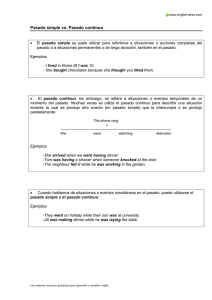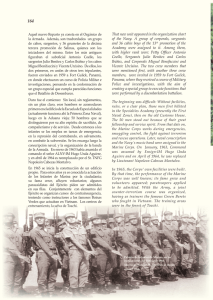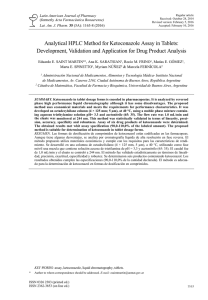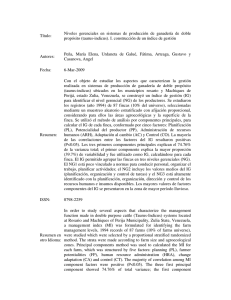Validación de una técnica potenciométrica para determinar el grado
Anuncio
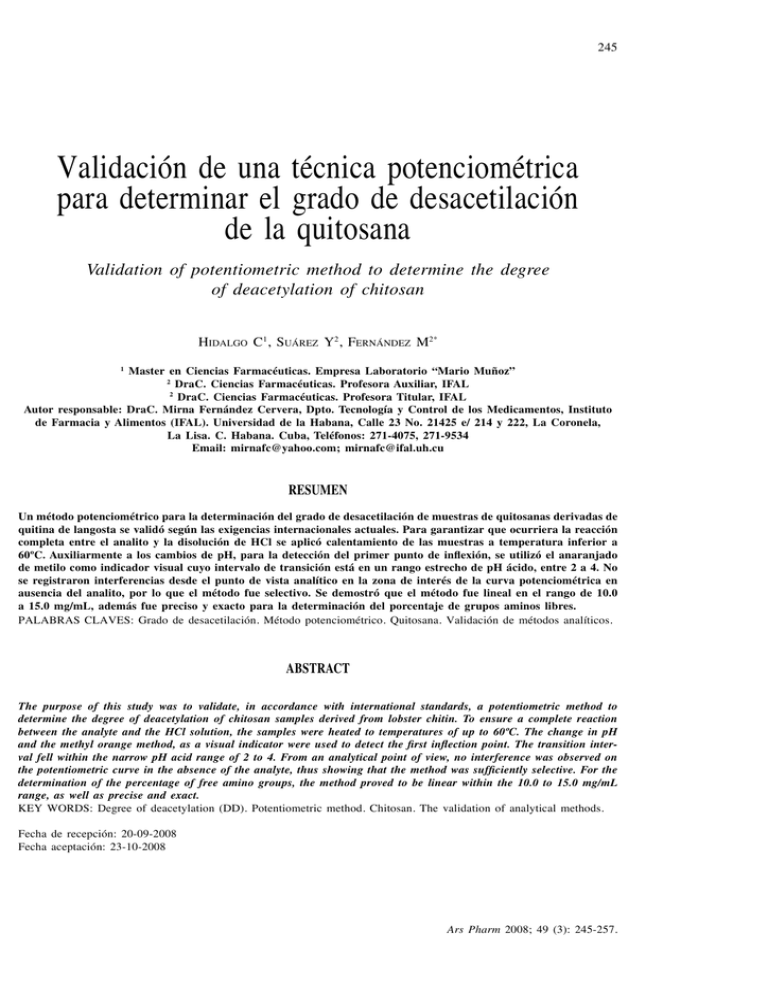
VALIDACIÓN DE UNA TÉCNICA POTENCIOMÉTRICA PARA DETERMINAR EL GRADO... VALIDATION OF POTENTIOMETRIC METHOD TO DETERMINE THE DEGREE OF DEACETYLATION... 245 Validación de una técnica potenciométrica para determinar el grado de desacetilación de la quitosana Validation of potentiometric method to determine the degree of deacetylation of chitosan HIDALGO C1, SUÁREZ Y2, FERNÁNDEZ M2* 1 Master en Ciencias Farmacéuticas. Empresa Laboratorio “Mario Muñoz” 2 DraC. Ciencias Farmacéuticas. Profesora Auxiliar, IFAL 2 DraC. Ciencias Farmacéuticas. Profesora Titular, IFAL Autor responsable: DraC. Mirna Fernández Cervera, Dpto. Tecnología y Control de los Medicamentos, Instituto de Farmacia y Alimentos (IFAL). Universidad de la Habana, Calle 23 No. 21425 e/ 214 y 222, La Coronela, La Lisa. C. Habana. Cuba, Teléfonos: 271-4075, 271-9534 Email: [email protected]; [email protected] RESUMEN Un método potenciométrico para la determinación del grado de desacetilación de muestras de quitosanas derivadas de quitina de langosta se validó según las exigencias internacionales actuales. Para garantizar que ocurriera la reacción completa entre el analito y la disolución de HCl se aplicó calentamiento de las muestras a temperatura inferior a 60ºC. Auxiliarmente a los cambios de pH, para la detección del primer punto de inflexión, se utilizó el anaranjado de metilo como indicador visual cuyo intervalo de transición está en un rango estrecho de pH ácido, entre 2 a 4. No se registraron interferencias desde el punto de vista analítico en la zona de interés de la curva potenciométrica en ausencia del analito, por lo que el método fue selectivo. Se demostró que el método fue lineal en el rango de 10.0 a 15.0 mg/mL, además fue preciso y exacto para la determinación del porcentaje de grupos aminos libres. PALABRAS CLAVES: Grado de desacetilación. Método potenciométrico. Quitosana. Validación de métodos analíticos. ABSTRACT The purpose of this study was to validate, in accordance with international standards, a potentiometric method to determine the degree of deacetylation of chitosan samples derived from lobster chitin. To ensure a complete reaction between the analyte and the HCl solution, the samples were heated to temperatures of up to 60ºC. The change in pH and the methyl orange method, as a visual indicator were used to detect the first inflection point. The transition interval fell within the narrow pH acid range of 2 to 4. From an analytical point of view, no interference was observed on the potentiometric curve in the absence of the analyte, thus showing that the method was sufficiently selective. For the determination of the percentage of free amino groups, the method proved to be linear within the 10.0 to 15.0 mg/mL range, as well as precise and exact. KEY WORDS: Degree of deacetylation (DD). Potentiometric method. Chitosan. The validation of analytical methods. Fecha de recepción: 20-09-2008 Fecha aceptación: 23-10-2008 Ars Pharm 2008; 49 (3): 245-257. HIDALGO C, SUÁREZ Y, FERNÁNDEZ M 246 INTRODUCCIÓN INTRODUCTION La Quitosana, principal derivado desacetilado de la Quitina, se obtiene a partir de los carapachos de crustáceos, fundamentalmente camarones, cangrejos y langostas1. A diferencia de los polímeros sintéticos, la Quitina y Quitosana, no presentan limitaciones en cuanto a biocompatibilidad, biodegradibilidad y toxicidad, son naturalmente abundantes y renovables2. Al igual que la Quitina, la Quitosana no se presenta como una molécula única. Muestra variabilidad en el tamaño de las cadenas y en el grado de desacetilación (GD), lo que influye en sus aplicaciones3,4. A pesar de la diversidad de métodos reportados para la determinación del grado de N-acetilación de la Quitosana, la potenciometría5-8 continua siendo uno de los métodos más simple, rápido y de bajo costo, requiriendo equipamiento y reactivos fácilmente disponibles en cualquier laboratorio. El método consiste en exponer la Quitosana a un exceso de disolución de ácido clorhídrico, ocurriendo la protonación del grupo amino libre de la Quitosana, valorando después esta disolución con hidróxido de sodio. El NaOH reacciona primero con el ácido libre en la disolución y después desplaza de la molécula de Quitosana el anión cloruro unido al grupo amino libre. La Quitosana precipita al quedar libre en un medio neutro, por lo que puede registrarse la diferencia de pH entre estos dos puntos y se obtiene una curva de pH frente a volumen de NaOH añadido, con dos puntos de inflexión. El primer y segundo punto de inflexión son equivalentes a la titración del exceso de ácido clorhídrico y al de la titración de la quitosana protonada, respectivamente8. La diferencia de volumen entre estos dos puntos se corresponde con el ácido consumido para la protonación de los grupos aminos y permite la determinación del GD de la Quitosana. La potenciometría es un método útil, siempre que el material a estudiar sea completamente soluble, ya que permite determinar el contenido de grupos aminos libres y por consecuencia el GD. Tiene la ventaja de que cuantifica los grupos aminos protonados directamente, por lo que no existe el problema de la no accesibilidad de los grupos aminos durante la etapa de protonación, como resultado de la formación de la sal, siempre que se emplee un ácido apropiado9,10. Durante la ejecución de un método potenciométrico varios errores pueden conducir a falsos resultados. La Chitosan, the main deacetylated derivative of chitin, is obtained from the shells of crustaceans, mainly shrimps, crabs and lobsters1. Both chitin and chitosan are viable polymer products, given that they do not present the same biocompatibility, biodegradability and toxicity limitations associated with the synthetic polymers. They are a naturally occurring, abundant and renewable resource2. As in the case of chitin, chitosan is not a uniform molecule. There are variations in the sizes of its chains and in the degree of deacetylation (DD), which influence its possible applications3,4. Among the methods used to determine the degree of N-acetylation of chitosan, potenciometry5-8 continues to be one of the most simple, quick and cost effective methods, requiring equipment and reagents commonly available in any laboratory. The method consists of exposing chitosan to an excess of hydrochloric acid, causing the free amino group of chitosan to be protonised. This solution is subsequently evaluated through the addition of sodium hydroxide. The NaOH reacts first with the free acid in the solution and then displaces the chloride anion, bound to the free amino group, from the chitosan molecule. The chitosan precipitates after being liberated into the neutral medium, allowing the difference in pH between these two points to be recorded. A pH curve against the volume of added NaOH can then be obtained, showing two inflection points. The first inflection point represents titration of excess hydrochloric acid and the second, titration of protonised chitosan8. The difference in volume between these two points represents the acid consumed in the protonation of the amino groups and allows the degree of chitosan deacetylation to be determined. Providing the material under study is completely soluble, potentiometry is a useful method, because it allows the content of the free amino group to be determined and therefore the DD. It presents the advantage of allowing the protonised amino groups to be quantified directly. Providing that an appropriate acid is used, the problem of inaccessibility to the amino groups during the protonation stage is overcome, as a result of the formation of salt9,10. However, errors leading to false results may occur when using potentiometric methods. Chitosan usually precipitates at pH > 6.011, thus reducing its concentration in the Ars Pharm 2008; 49 (3): 245-257. VALIDACIÓN DE UNA TÉCNICA POTENCIOMÉTRICA PARA DETERMINAR EL GRADO... VALIDATION OF POTENTIOMETRIC METHOD TO DETERMINE THE DEGREE OF DEACETYLATION... Quitosana precipita normalmente a pH > 6.011 reduciendo su concentración en la solución; además de producirse posibles acumulaciones sobre los electrodos disminuyendo la precisión del método, por lo que se requiere restringir la titración hasta valores de pH ≤ 6.0. Los errores en las mediciones de pH y su reproducibilidad constituyen una de las principales limitantes de este método, provocando inexactitudes en la determinación de los puntos de inflexión de las curvas resultantes. Teniendo en cuenta la diversidad de fuentes de obtención de Quitosana, materia prima, y el hecho de no existir métodos de referencia descritos en farmacopeas se hace necesario disponer de métodos validados confiables para la determinación del GD de la Quitosana. La validación de un método analítico es el proceso establecido por los estudios de laboratorio para garantizar el cumplimiento de una serie de requisitos indispensables para la futura aplicación analítica del método. Es necesaria porque proporciona un alto grado de confianza y seguridad del proceso productivo, o del método analítico, así como también en la calidad de los resultados. Estos requisitos son expresados en términos de parámetros analíticos12-14. El objetivo del presente estudio es desarrollar un método potenciométrico preciso, selectivo, exacto y lineal para la determinación del grado de desacetilación de la Quitosana materia prima. 247 solution. This in addition to possible accumulations on the electrodes reduces the precision of the method. It is therefore necessary to restrict titration to pH values of up to pH ≤ 6.0. Errors in the measurement of pH and the low degree of reproducibility of the method are limiting factors that lead to inexactness in the determination of the inflection points in the resulting curves. However, although chitosan as a raw material is obtainable from a great variety of sources, no methods for use as reference have been described in pharmacopoeias. Consequently, reliable validated methods are required to determine the DD of chitosan. The validation of an analytical method is required in laboratory studies to guarantee the fulfilment of a number of essential requirements for the future analytical application of the method. It serves to provide greater degrees of reliability and confidence in productive processes or in analytical methods and therefore the veracity of the results obtained. These requirements are expressed in terms of analytical parameters12-14. The objective of this study was to develop a precise, selective, exact and linear potentiometric method to determine the degree of deacetylation of chitosan as a raw material. MATERIALS AND METHODS Chemical products and reagents MATERIALES Y MÉTODOS Productos químicos y reactivos Quitina obtenida a partir de carapachos de langosta y muestras de Quitosana obtenidas por desacetilación termoalcalina (Q5040 y Q4540) suministradas por la Empresa Laboratorio “Mario Muñoz” (Cuba). Muestras comerciales de Quitosana de alta (HMW, 79% GD) y media masa molecular (MMW, 81,4% GD) (Aldrich, USA) derivadas de carapachos de camarón, como materiales de referencia para las muestras de Quitosanas cubanas. El resto de los reactivos y soluciones fueron de calidad analítica. Chitin obtained from lobster shells and samples of chitosan obtained from thermo alkaline deacetylation (Q5040 and Q4540) were supplied by the Mario Muñoz laboratory, Cuba. High molecular weight chitosan (HMW, 79% DD) and medium molecular weight chitosan (MMW, 81.4% GD) (Aldrich, USA) from shrimp shells, were used as reference material for Cuban chitosan samples. All reagents and solutions were of analytical quality. Quantification of free amino groups The determination of the percentage of free amino groups was carried out using a potentiometric technique15, with the analysis of Q5040, Q4540 and commercial samples carried out in triplicate. Ars Pharm 2008; 49 (3): 245-257. 248 HIDALGO C, SUÁREZ Y, FERNÁNDEZ M Ensayo del porcentaje de grupos aminos libres Determination of dissolution time in HCl La determinación del porcentaje de grupos aminos libres se realizó a través de una técnica potenciométrica15, analizando por triplicado las muestras Q5040, Q4540 y las comerciales, respectivamente. The optimum dissolution time for chitosan, was determined by dissolving samples of Q4540 and Q5040 in 12.5mg/mL of HCl at 30 ± 2ºC and recording the pH of the solution at intervals of 1h (Phmetro Metrohm, 620-phmeter, Switzerland), for six hours. The samples were left to stand for another 10 hours, during which determinations were carried out every hour, until three consecutively equal pH values were obtained. The chitosan samples were simultaneously heated (55 ± 2°C), with moderate stiring before potentiometric evaluation at room temperature. pH was then measured at 30, 60 and 90 min after exposure. Determinación del tiempo de disolución en HCl Para establecer el tiempo óptimo de disolución de la Quitosana en HCl se procesaron muestras de Q4540 y Q5040 a 12,5mg/mL, respectivamente, a 30 ± 2°C y se registró el pH de la solución a intervalos de 1h (Phmetro Metrohm, 620-phmeter, Suiza), durante seis horas. Se dejaron en reposo durante 10 horas más, y se realizó la determinación, cada una hora, hasta obtener tres valores de pH consecutivos iguales. Simultáneamente las muestras de Quitosana se calentaron (55 ± 2°C), con agitación moderada antes de realizar la medición potenciométrica a temperatura ambiente. Se midió el pH a los 30, 60 y 90 min de exposición. Detección del punto de inflexión menor Para determinar conjuntamente con el cambio de pH del medio, el primer salto de potencial de la curva potenciométrica se realizó la incorporación de un indicador visual. La selección del indicador se realizó por el análisis de los intervalos de transición respecto al punto de equivalencia de la reacción entre la Quitosana y el exceso de HCl, seleccionando el anaranjado de metilo, el cual se añade al valorar a temperatura ambiente. Técnica potenciométrica aplicada Se pesaron 0,3g de muestra y se disolvieron en 25mL de una disolución de HCl 0.1M. Para ajustar la fuerza iónica del medio a 0,1 se adicionó la cantidad necesaria de KCl a la solución. Tras 1h de agitación en zaranda con baño termostatado (Gallenkamp, Inglaterra) ajustado a 55 ± 2°C, se realizó la valoración potenciométrica con disolución de NaOH 0.1M a 30 ± 2°C, en presencia de anaranjado de metilo, empleando un pHmetro Metrohm, Suiza. Para lograr mediciones precisas se calibró el equipo con soluciones tampones con Ars Pharm 2008; 49 (3): 245-257. Detection of the lower inflection point To determine this parameter in conjunction with the change in pH of the medium, the first potential jump of the potentiometric curve was carried out with the incorporation of a visual indicator. The selection of the indicator was carried out by analysing the transition intervals in comparison with the equivalence points of the reaction between chitosan and the excess of HCl. The most appropriate indicator was orange methyl, which was added for evaluation purposes at room temperature. Applied potentiometric technique 0.3g of sample were added and dissolved in 25mL of 0.1m HCl solution. To adjust the ionic strength of the medium at 0.1, the necessary quantity of KCl was added to the solution. After stiring for 1h through a sieve with a thermostatic bath (Gallenkamp, England) at 55 ± 2°C, a potentiometric evaluation was carried out with a 0.1m NaOH solution at 30 ± 2°C, in the presence of methyl orange, using a Metrohm pH meter, Switzerland. To obtain precise measurements, the equipment was calibrated with buffer solutions at the following pH: 7.01; 4.01 and 10.1. The evaluation solution, previously standardised with potassium biftalate as primary standard, was added in quantities of 0.5mL, with the potentiometric determinations recorded after each addition. Evaluation was carried out by measuring the change in pH after each 2 mL VALIDACIÓN DE UNA TÉCNICA POTENCIOMÉTRICA PARA DETERMINAR EL GRADO... VALIDATION OF POTENTIOMETRIC METHOD TO DETERMINE THE DEGREE OF DEACETYLATION... los siguientes pH: 7,01; 4,01 y 10,1. Se adicionó el valorante, el cual fue estandarizado previamente con biftalato de potasio como patrón primario, a razón de 0,5mL registrando los valores de potencia en cada adición. La valoración se llevó a cabo midiendo el cambio de pH cada 2 mL de base añadida, la adición se realizó de forma lenta y con agitación continúa para homogenizar la solución y evitar errores debidos a la posible precipitación del biopolímero. Se realizaron tres réplicas y se calculó el % de grupos aminos libres empleando la siguiente expresión15: 16,1 x (Pto inflexión mayor – Pto inflexión menor) x Molaridad solución NaOH % NH2 = --------------------------------------------Masa de quitosana Validación del método potenciométrico La técnica potenciométrica se validó según los parámetros exigidos por la USP 28, 200514. — Linealidad del sistema Se analizaron cinco concentraciones de Quitosana por triplicado, en un rango de 80 - 120% de la cantidad teórica declarada, equivalentes a 10,0; 11,2; 12,5; 13,7 y 15,0 mg/mL, respectivamente. Se construyó una curva de calibración de concentración experimental expresada como 1/NH2 vs concentración teórica (%). Los resultados se procesaron estadísticamente a través del paquete STATISTICA for Windows versión 6,01 (opción regresión lineal múltiple) y se determinó: r (coeficiente de correlación lineal), r2 (coeficiente de determinación), a (intercepto) y b (pendiente), para un 95% de confianza. — Exactitud Se construyó una curva de recuperación de % recuperado (Y) vs % añadido (X) de los puntos equivalentes al 90, 100 y 110 % analizando por triplicado cada nivel de concentración. Los resultados fueron procesados estadísticamente de igual forma que la curva de calibración de la linealidad del sistema calculándose el porcentaje de recuperación (R) y el coeficiente de variación (CV) total. Se realizó la prueba G de Cochran, para determinar si el factor de concentración tiene alguna influencia en los resultados. Por último se aplicó la prueba t de Student para demostrar que 249 addition of base solution. Additions were made slowly with continuous stirring to homogenise the solution and to avoid any errors that could arise from biopolymer precipitation. Three replicates were peformed and the percentage of free amino groups was carried out according to the following expression15: 16.1 x (higher inflection point – lower inflection point) x molarity of NaOH solution % NH2 = ----------------------------------------chitosan mass Validation of the potentiometric method The potentiometric technique was validated according to the parameters established by the USP 28, 200514. — Linearity of the system Five chitosan concentrations per triplicate were analysed within a range of 80 – 120% of the theoretical declared quantity, equivalent to 10.0, 11.2, 12.5, 13.7 and 15.0 mg/mL, respectively. A calibration curve of experimental concentration expressed as l/NH2 vs theorectical concentration (%) was plotted. The results were statistically processed using the statistical package for Windows, version 6.01 (multiple linear regression option) and the following parameters were determined: r (coefficient of linear correlation), r2 (coefficient of determination), a (intercept) and b (slope), for a reliability of 95%. — Exactness A recovery curve (Y) was plotted of the recovered percentage vs the percentage added (X) of the points equivalent to 90, 100, and 110% analysed per triplicate at each level of concentration. The results were processed statistically in the same way as those for the calibration curve of system linearity, calculating the percentage of recovery (R) and the coefficient of total variation (CV). The Cochran’s G test was used to determimine whether the concentration factor had any influence on the results. Finally, the student t test was used to demonstrate that there were no significant differences between the average recovery values obtained and the 100% reference sample. Ars Pharm 2008; 49 (3): 245-257. HIDALGO C, SUÁREZ Y, FERNÁNDEZ M 250 no existían diferencias significativas entre el valor medio de recuperación obtenido y el 100%. — Precisión • Repetibilidad Para la repetibilidad se evaluaron por triplicado muestras con la concentración equivalente al 90, 100 y 110%, comprendidos dentro del rango de la linealidad del método. Se calculó el CV para los tres niveles de concentración y se comparó con el criterio establecido. Las determinaciones las realizó el mismo analista en las mismas condiciones de trabajo. • Precisión intermedia Participaron dos analistas, en dos días diferentes, en el mismo laboratorio. Se analizaron por triplicado, en cada caso, muestras equivalentes al 100%. Se calculó el CV total. Se realizó la Prueba F de Snedecor para determinar si existían diferencias significativas entre los resultados de los analistas que emplearon el mismo método y entre los días en que se realizaron los análisis, y la Prueba de t de Student para comprobar si los valores obtenidos entre los analistas, que emplearon igual método, y los dos días en que realizaron los análisis eran homogéneos, para el nivel de significación α= 0,05. — Selectividad Se analizó una muestra compuesta por una disolución de HCl 0.1M e indicador y otra de Quitina y disolución de HCl, ya que es el material de partida para la obtención de la Quitosana. En cada caso se registró la curva potenciométrica correspondiente y se comparó con la curva obtenida al valorar una muestra de Quitosana equivalente al 100% (12,5 mg/mL). — Rango Se estableció el intervalo en que se cumplen los criterios de linealidad, exactitud y precisión. RESULTADOS Y DISCUSIÓN Durante la ejecución experimental del método potenciométrico15 se observó una demora en la reacción completa del analito, ya que para la disolución de la muestra transcurrieron más de 6h. Al analizar los valores de pH se observaron Ars Pharm 2008; 49 (3): 245-257. — Precision • Repeatability For repeatability analysis, samples were evaluated in triplicate, with a concentration equivalent to 90, 100 and 110%, within the linearity range of the method. The CV for the three concentration levels was calculated and compared with established criteria. Determinations were performed by the same analyst, under the same working conditions. • Intermediate precision At the same laboratory, two researchers carried out analyses over two days. Triplicate analyses were performed in each case for samples that were equivalent to 100%. Total CV was calculated. For identical analytical methods, the Snedecor’s F test was used to check for significant differences for the results obtained by each analyst and the results for each day of analyses by the same analyst. The student t test was used to check for homogeneity for the values obtained between each analyst and between each day of analyses, for the significance level α= 0.05. — Selectivity Analyses were performed on a sample composed of a 0.1M HCl solution and indicator, and another composed of chitin and HCl solution, given that this is material from which chitosan is obtained. For each case, the potentiometric curve was recorded and compared with the curve obtained from the 100% chitosan sample (12.5 mg/mL). — Range The interval at which the criteria of linearity, exactness and precision was determined. RESULTS AND DISCUSSION. During performance of the potentiometric method15, completion of the analyte reaction was delayed, given that dissolution of the sample took more than 6 hours. The differences observed in ph values (Table 1) revealed that the total dissolution of chitosan in the acid had not occurred in any of the samples analysed. The time required for the dissolution of chitosan in HCl at 30 ± 2°C was determined after obtaining constant constant pH values and occurred spontaneously after VALIDACIÓN DE UNA TÉCNICA POTENCIOMÉTRICA PARA DETERMINAR EL GRADO... VALIDATION OF POTENTIOMETRIC METHOD TO DETERMINE THE DEGREE OF DEACETYLATION... diferencias en los mismos (Tabla 1), indicando que la disolución de la Quitosana en el ácido no se había completado en ninguna de las muestras analizadas. Para ello se estableció el tiempo de exposición de la Quitosana en la disolución de HCl a 30 ± 2°C, a partir de los valores constantes de pH, para conocer cuándo había ocurrido totalmente la reacción. Se obtuvo como resultado, que de forma espontánea, este proceso tardaba aproximadamente 20 horas. Por ser un tiempo excesivamente prolongado, se aplicó calentamiento a 55 ± 2°C, de forma que no ocurriera la hidrólisis de los enlaces glicosídicos16 de la molécula de Quitosana. Los resultados mostraron un tiempo óptimo de 1h de exposición, siendo los valores de pH constantes (pH = 1,6 ± 0,0), aún a los 90 min. 251 approximately 20 hours. To reduce this excessive dissolution time, the solution was heated to 55 ± 2°C, to prevent the hydrolisis of the glicoside bonds of the chitosan melecule16. This heating proceedure reduced dissolution to an optimal time of 1 hour, with constant pH values (pH = 1.6 ± 0.0) still remaining at 90 minutes. TABLA 1. Determinación del pH a las muestras de Quitosana disueltas (6 h). TABLE 1. The determination of pH in samples of disolved chitosan (6 h). Resultados Results Valores de pH inicial Initial pH values Q5040 Q4540 1.1 1.4 1.0 1.3 0.9 1.2 Media ± DS Average ± DS 1.0 ± 0.1 1.3 ± 0.1 CV (%) CV (%) 10.0 7.7 Réplicas Replicates Se realizó una búsqueda de los indicadores visuales, cuyo intervalo de transición se ajustara al valor del pH del punto de equivalencia de manera, que conjuntamente con el cambio de pH del medio, el cambio de coloración que se produce por la presencia del indicador permitiera confirmar el primer salto de potencial. El indicador visual seleccionado debía tener su zona de viraje en un rango estrecho de pH ácido, principalmente de 2 a 4, por lo que el más adecuado fue el anaranjado de metilo. Este indicador presenta coloración amarilla en medio básico y coloración roja en medio ácido14. A search was made for visual indicators, whose transition interval would coincide with the pH value of the equivalence point, so that together with the change in pH of the medium, the change in colouring occurring, due to the presence of the indicator, would allow confirmation of the first potential jump to be obtained. An appropriate visual indicator would be one whose transition point from one colour to another, occurs within a narrow acid pH range, mainly from 2 to 4. In this respect, methyl orange was found to be the most appropriate. This indicator presented a yellow colouring in basic medium and red in acid medium14. Validación del método potenciométrico Validation of the potentiometric method Los resultados experimentales de la linealidad del sistema se muestran en la Figura 1 y los resultados del procesamiento estadístico se The experimental results for system linearity are shown in Figure 1 and the results from staArs Pharm 2008; 49 (3): 245-257. HIDALGO C, SUÁREZ Y, FERNÁNDEZ M 252 resumen en la Tabla 2. Según el cumplimiento de los parámetros estadísticos establecidos (Tabla 2) se avala la linealidad del sistema. El conjunto de estos resultados permitió afirmar que el método fue lineal en el rango estudiado, ya que se obtuvo una elevada proporcionalidad entre la respuesta obtenida y la concentración del analito, tal como se muestra en la Figura 1 y se demuestra por el cumplimiento de todos los criterios estadísticos que derivan del análisis de la regresión. tistical processing are summarised in Table 2. Evidence of system linearity can be confirmed by fulfilment of the established statistical parameters (Table 2). Within the range studied, the results obtained confirmed the linearity of the method, given that there was a high degree of correlation between the response obtained and the concentration of analyte (Figure 1), and that the statistical criteria from regression analysis had been fulfilled. FIGURA 1. Curva de calibración obtenida para la linealidad del sistema. FIGURE 1. Calibration curve obtained for the linearity of the system. Linealidad del sistema 1/NH 2 (%) = 0,0016+0,0012*x 0,16 0,15 0,14 0,13 2 (%) 1/NH 0,12 0,11 0,10 0,0975 80 85 90 95 100 Conc (%) Ars Pharm 2008; 49 (3): 245-257. 105 110 115 120 125 VALIDACIÓN DE UNA TÉCNICA POTENCIOMÉTRICA PARA DETERMINAR EL GRADO... VALIDATION OF POTENTIOMETRIC METHOD TO DETERMINE THE DEGREE OF DEACETYLATION... 253 TABLA 2. Resumen del procesamiento estadístico de los resultados de la validación. TABLE 2. Summary of the statistical processing of the validation results. Parámetro Parameter Linealidad del método Linearity of the method Resultados Results Y = 0.0012X + 0.0016 r = 0.9996 r2 =0.9993 texp < ttab (α= 0.05, n= 13) texp = 1.86 < ttab = 2.16 b = 0.0012 t = 143.4689 p = 0.0000 CVf = 0.3778 texp = -1.4173 < ttab = 2.36 b = 1.0008 t = 730.2931 p = 0.0000 R total = 100.34% CV total = 0.64% R total = 97-103% CV total ≤ 3.0 % Gexp = 8.3065 x 10-5 Gtab = 0.8709 Test de Cochran Cochran test Gexp < Gtab (α=0.05, K=3, n=3) texp = 1.309 < ttab = 12.71 Repetibilidad Repeatability Y= bx+a r ≥0.99 r2 ≥0.98 intercepto no significativo Non-significative intercept texp < ttab (2.16) b≅ 1 t alta t high p ≤ 0.005 CVf < 5% Y = bx+a r ≥ 0.99 r2 ≥ 0.98 intercepto no significativo Non-significative intercept texp < ttab (2.36) b≅ 1 t alta t high p ≤ 0.005 Y = 1.0008X - 0.1963 r = 0.9999 r2 = 0.9999 texp < ttab (α= 0.05, n= 7) Exactitud Exactness Criterio de aceptación Acceptance criteria CV CV CV = 0.4340% = 0.0012% = 1.1876% 110% 90% 100% Test t Student Student t test texp < ttab (12.71) CV ≤ 1.5 % ≤ 3.0 % CV = 2.0471 % CV Fexp = 0.1334, texp = 0.6423 Fischer (F) y Student (t) Fisher (F) and Student (t) entre analistas between analysts Ftab = 5.05 , ttab = 2.23 Precisión intermedia Intermediate precision F exp = 0.4505, texp = 0.0753 Para evaluar la exactitud se determinó el porcentaje de recuperación (R) de los puntos equivalentes a tres niveles de concentración y se construyó la curva de recuperación (Figura 2). Al realizar el procesamiento estadístico (Tabla 2) se comprobó el cumplimiento de todos los criterios exigidos según la regresión lineal aplicada. El coeficiente de recobrado medio no excedió el total Fischer (F) y Student (t) Fisher (F) and Student (t) entre días for results between days Ftab = 5.05 , ttab = 2.23 To evaluate exactness, the recovery percentage (R) of the equivalent points at three concentration levels were determined, from which a recovery curve was plotted (Figure 2). Statistical processing (Table 2) confirmed fulfilment of all established criteria in accordance with the linear regression applied. The coefficient of average recovery did not exceed the limit of 97-103%. Furthermore, Ars Pharm 2008; 49 (3): 245-257. HIDALGO C, SUÁREZ Y, FERNÁNDEZ M 254 límite de 97-103%. Además el CV total quedó comprendido en el rango de aceptación acotado por un límite superior o igual al 3%. total CV fell within the accepted range limits for a limit equal to or higher than 3%. FIGURA 2. Curva de recuperación obtenida en la exactitud del método. FIGURE 2. The recovery curve obtained from the results for exactness of the method. Curva de recuperación Conc experimental = -0,1963+1,008*x 112 110 108 Conc experimental 106 104 102 100 98 96 94 92 90 88 88 90 92 94 96 98 100 102 104 106 108 110 112 Conc teórica Adicionalmente se evaluó la influencia de la concentración de analito en la varianza de los resultados (S) a través de la prueba de G de Cochran. Como la Gexp < Gtab , las varianzas de los tres niveles de concentración evaluados, fueron equivalentes. Es decir, no influyó el factor concentración en la exactitud del método. Por su parte, la prueba de t Student corroboró la exactitud, ya que la t obtenida fue inferior a la tabulada, por lo que no existieron diferencias estadísticamente significativas entre el recobrado medio y el 100%. Por esta razón se puede afirmar que la técnica fue exacta y no se afectó por errores sistemáticos de forma significativa. Para la repetibilidad se estimó el CV para tres niveles de concentración: bajo, medio y alto. Se reportaron CV bajos, inferiores al 1,5% establecido como límite (Tabla 2). La precisión intermedia también fue evaluada dando resultados satisfactorios (Tabla 3). Se obtuvo un CV acorde con el criterio de aceptación que plantea un CV ≤ 3,0%, de modo que los errores aleatorios no repercutieron en gran medida sobre el método desarrollado. Este análisis se complementó con las pruebas de Fischer y t Student (Tabla 2). En ambos análisis la Fexp < Ftab por lo que no existieron diferencias significativas entre las precisiones de los analistas, independienteArs Pharm 2008; 49 (3): 245-257. In addition, the influence of the concentration of analyte on the variance of the results (S) was evaluated using the Cochran’s G test. As Gexp < Gtab, variance in the three concentrations studied were equivalent. The concentration factor had no influence therefore on the exactness of the method. The Student t test corroborated exactness, with a lower t value than the tabulated t value, showing no statistically significant differences between average recovery and the 100% sample. Consequently, the technique can be confirmed as being exact and not affected significantly by system errors. To assess repeatability, CV was estimated at three concentration levels: low, medium and high. The low CV values found, lower than 1.5% were established as a lower limit (Table 2). The results for intermediate precision were also satisfactory (Table 3). A CV was obtained which fulfilled the acceptance criteria for a CV of ≤ 3.0%. Random errors therefore did not affect the method to any great degree. This analysis was complemented with a Fisher’s F and Student t tests (Table 2). In both analyses Fexp < Ftab , showing no significant differences in the results obtained by the analysts, regardless of the day the test was performed. Values for texp were lower than ttab, in every case, showing no significant differen- VALIDACIÓN DE UNA TÉCNICA POTENCIOMÉTRICA PARA DETERMINAR EL GRADO... VALIDATION OF POTENTIOMETRIC METHOD TO DETERMINE THE DEGREE OF DEACETYLATION... mente del día en que se efectúo el ensayo. Los valores de las texp resultaron menores que las ttab, en cada caso, por lo que no existieron diferencias significativas entre los valores medios obtenidos por los analistas. El conjunto de estos resultados permite asegurar que los resultados fueron homogéneos, ratificando la precisión del método en estudio. 255 ces among the average values obtained by the analysts. The consistency found in all of these results confirm the precision of the method. TABLA 3. Resultados de la precisión intermedia. TABLE 3. Results for intermediate precision. Concentración experimental 1/ NH2 (%) Experimental concentration 1/NH2 (%) Analistas Analyst Analista 1 Analyst 1 Analista 2 Analyst 2 Día 1 Day 1 Día 2 Day 2 0.126 0.128 0.127 0.128 0.125 0.128 0.127 0.120 0.130 0.126 0.124 0.127 Se demostró que el método fue selectivo para la Quitosana, al registrar las curvas potenciométricas en ausencia del analito (Figura 3). Como se observa, no aparecen interferencias desde el punto de vista analítico en la zona de interés, ya que no se obtuvo el salto de potencial correspondiente a la reacción de Quitosana con el exceso de HCl, el cual ocurre a pH entre 2 y 4, como se aprecia en las curvas potenciométricas de las muestras comerciales de referencia HMW y MMW, respectivamente (Figura 4). The fact that potentiometric curves were obtained in the absence of the analyte shows that the method was selective for chitosan (Figure 3). In this figure, no interference, from an analytical point of view can be observed in the area of interest, given that no potential jump for a chitosan reaction with excess HCl was obtained. This would normally occur at a pH between 2 and 4, as can be seen in the potentiometric curves from commercial reference samples HMW and MMW respectively (Figure 4). FIGURA 3. Curvas potenciométricas para la selectividad del método. FIGURE 3. Potentiometric curves for the selectivity of the method. Indicador Quitina 6 10 5 8 pH 4 pH 6 3 4 2 2 1 0 0 0 5 10 15 20 25 5 10 15 20 25 Volumen de NaOH Volumen de NaOH Quitina Indicador Ars Pharm 2008; 49 (3): 245-257. HIDALGO C, SUÁREZ Y, FERNÁNDEZ M 256 FIGURA 4. Curvas potenciométricas para las muestras comerciales de Quitosana HMW y MMW. FIGURE 4. Potentiometric curves for HMW and MMW commercial chitosan samples. Patrón MMW 7 Patrón HMW 7 6 6 5 pH 5 4 pH 4 3 3 2 2 1 1 5 10 15 20 volumen de NaOH HMW 0 2 4 6 8 10 12 14 16 18 Volumen de NaOH MMW El cumplimiento de las exigencias internacionales para la validación de técnicas analíticas garantiza que el procedimiento desarrollado, fue lineal, preciso y exacto para la estimación de este importante parámetro en la caracterización físicoquímica de la Quitosana en el rango analizado, de 10,0 a 15,0 mg/mL. This method complied with international standards for the validation of analytical techniques, and therefore guarantees that this procedure is linear, precise and exact for the estimation of this important parameter in the physico-chemical characterisation of chitosan, within the range of 10.0 to 15.0 mg/mL. Aplicación del método en las muestras de ensayo y referencia The application of the method in experimental and reference samples Con la técnica potenciométrica validada para la determinación del porcentaje de grupos aminos libres, se realizó la determinación del grado de desacetilación a las muestras de Quitosana nacionales y de referencia (Tabla 4). Tales resultados son congruentes con los obtenidos previamente por espectroscopia infrarroja y de 13C-RMN17,18. No obstante, la comparación de los resultados se hace difícil, más aún, cuando se trabajan diferentes fuentes de Quitina para producir Quitosana, y diversos también son los procedimientos para su caracterización. After validation of the potentiometric technique for the determination of the percentage of free amino groups, the degree of deacetylation for both national and reference chitosan samples was determined (Table 4). The results obtained were consistent with previously obtained results from infrared spectroscopy and from 13C-NMR17,18. However, the comparison of results is difficult and even more so, when different sources of chitin are used to produce chitosan. Similarly, there is no one universal procedure used for its characterisation. Ars Pharm 2008; 49 (3): 245-257. VALIDACIÓN DE UNA TÉCNICA POTENCIOMÉTRICA PARA DETERMINAR EL GRADO... VALIDATION OF POTENTIOMETRIC METHOD TO DETERMINE THE DEGREE OF DEACETYLATION... 257 TABLA 4. Resultados del grado de desacetilación (%) por potenciometría. TABLE 4. Results from potentiometry for degree of deacetylation (%) Muestras Samples Método colorimétrico* Colorimetric method* Potenciometría (bs) Potentiometry (DB) Q4540 - 90.63 ± 0.06 Q5040 - 80.06 ± 1.20 MMW 81.40 79.46 ± 1.72 HMW 79.00 81.26 ± 1.76 CONCLUSIÓN CONCLUSION El método propuesto resultó válido para determinar el GD en diferentes muestras de Quitosana. The proposed method for the determination of DD in different chitosan samples was successfully validated. BIBLIOGRAFÍA/BIBLIOGRAPHY 1. Agulló E, Mato R, Peniche C, Tapia C, Heras A, Pastor de Abram A. Generalidades. En: Pastor de Abram A. (ed.) Quitina y Quitosano: obtención, caracterización y aplicaciones. Programa CYTED, CIAD y Pontificia Universidad Católica del Perú. Lima, Perú. 2004; Agosto: pp. 44-48. 2. Singla AK, Chawla M. Chitosan: some pharmaceutical and biological aspects-an update. J. Pharm. Pharmacol. 2001; 53: 1047-1067. 3. Chatelet C, Damour O, Domard, A. Influence of the degree of acetylation on some biological properties of chitosan films. Biomaterials. 2001; 22(3): 261-268. 4. Argüelles W, Heras Caballero A, Acosta N, Galed G, Gallardo A, Miralles B, et al. Caracterización de quitina y quitosano. En: Pastor de Abram A. (ed.) Quitina y Quitosano: obtención, caracterización y aplicaciones. Programa CYTED, CIAD y Pontificia Universidad Católica del Perú. Lima, Perú. 2004; Agosto: pp. 195-197. 5. Broussignac P. Chemistry Industry Genie Chimica. 1968; 99: 1241. 6. Muzzarelli RAA. Chitin. Pergamon Press, Oxford. 1977. 7. Ke H, Chen Q. Potentiometric titration of chitosan by linear method. Huaxue Tongbao. 1990; 10: 44-46. 8. Xuan J, Lirong Ch, Wei Z. A new linear potentiometric titration method for the determination of deacetylation degree of chitosan. Carbohydr. Polym. 2003; 54: 457-463. 9. Domszy JG, Roberts GAF. Evaluation of infrared spectroscopic techniques for analysing chitosan. Makromol. Chem. 1985; 186: 1671-1677. 10. Khan TA. Reporting degree of deacetylation values of chitosan: the influence of analytical methods. J. Pharm. Pharmaceutic. Sci. 2002; 5(3): 205-212. 11. Domard A, Rianudo M. Preparation and characterization of fully deacetylated chitosan. Inter. J. of Biological Macromolecules. 1983; 5: 49-52. 12. ICH Q2A. Harmonised Tripartite Guideline. Text on Validation of Analytical Procedures. 1995, Disponible en http// www.fda.gov 13. Shap J. Quality in manufacture of medicines and other healthcare products. Part 5: Quality control. London: Pharmaceutical Press; 2000. p. 283-358. 14. United State Pharmacopeia (USP 28). United States Pharmacopoeia XXVIII and National Formulary 23st: United States Pharmacopeial Convention. 2005, Versión Electrónica. 15. Broussignac P. Chitosan: a natural polymer not well known by the industry. Chem. Ind. Genie Chem. 1968; 99(9): 1241-1247. 16. Solomons TWG. Fundamentals of Organic Chemistry. 4ta Edition, 1994. ISBN-047158987-X. 17. Fernández M, Heinämäki J, Räsänen M, Maunu SL, Karjalainen M, Yliruusi J et al. Solid-state characterization of chitosans derived from lobster chitin. Carbohydr. Polym. 2004; 58: 401-408. 18. Hidalgo C. Caracterización de quitosanas derivadas de quitina de langosta. Tesis de Maestría. Instituto de Farmacia y Alimentos, Universidad de la Habana, 2007. Ars Pharm 2008; 49 (3): 245-257.
